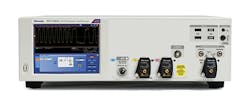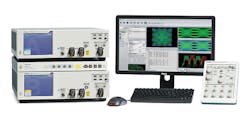This file type includes high resolution graphics and schematics when applicable.
Use of the frequency spectrum continues to climb into the higher frequencies. Once a curiosity, millimeter-wave frequencies are becoming commonplace, increasingly being used to transfer high-speed data across short distances. Of course, to maintain such communications functions, testing at those millimeter-wave frequencies is necessary.
On that front, the DPO70000SX 70-GHz oscilloscope developed by Tektronix is designed for the needs of today and tomorrow, with high resolution across a 70-GHz bandwidth and a lightning-fast sampling rate of 200 Gsamples/s. This instrument captures and displays the most elusive of signals at frequencies through 70 GHz, which aids developers of both microwave and optical systems.
The first impression of the DPO70000SX oscilloscope (Fig. 1) is its low-profile housing in a housing that stands a mere 5.25 in. tall, or about one-half the height of a standard oscilloscope. Admittedly, the low profile translates into a relatively compact display screen. But in a typical research-and-development (R&D) measurement application, the DPO70000SX oscilloscope can be teamed with an external display screen (Fig. 2) for ease of viewing. The scope’s compact-size housing also makes it easier to place the instrument closer to a device under test (DUT).
All models in the new oscilloscope series deliver better than 25-GHz edge-trigger performance, with glitch-trigger performance of better than 30 ps. They employ a new window-type trigger that can be applied on the envelope of RF/microwave signal bursts, and use time qualifications to discriminate precise widths of those envelopes. A pulse-width timer makes it possible to discriminate specific pulse widths in high-speed serial data streams, as well as identify “runt” or random pulses as part of pseudorandom pulsed signal trains. The trigger input features low-jitter edge triggering, and can be used with a number of the firm’s different signal-conditioning accessories.
Channel Options
The DPO70000SX oscilloscope offers a high degree of measurement flexibility, since it can be used as a single- or dual-channel scope. As a dual-channel oscilloscope, it captures signals across each of two 33-GHz-wide channels at a sample rate of 100 Gsamples/s per channel. In two-channel mode, it can handle single-ended signal levels from 62.5 to 6.00 V (full scale of reading). When all the measurement power is focused into a single channel, the scope operates across a 70-GHz bandwidth with better than 6-ps rise time and a sample rate of 200 Gsamples/s. In single-channel operation, it handles single-ended signal levels from 100 to 300 mV (full scale of reading). In either operating mode, the instrument provides as much as 1-Gsample/s record length.
When two channels are not enough, the UltraSync bus integrated into each oscilloscope helps achieve multiple-instrument hookups with precise timing for high-speed measurements. The UltraSync bus synchronizes sample clock, trigger, and run-stop control across multiple oscilloscopes with performance matching that of a single instrument. The UltraSync bus employs a 12.5-GHz sample clock reference source and coordinated trigger bus to minimize jitter—between channels and from acquisition to acquisition—to less than 500 fs (RMS).
The oscilloscope’s high-speed data path makes it possible to transfer waveform data from extension instruments to a master instrument in a multiple-instrument measurement system. Since each scope in a multiple-instrument setup processes its own acquired signals, it sends processed waveforms to a master unit, helping to maintain top performance even when adding more instruments to a setup.
In addition, the oscilloscope can be controlled remotely over the Internet via a Windows Remote Desktop utility. Network cables for UltraSync connections come in 1- and 2-m lengths for different instrument setups. Any DPO70000SX oscilloscope in a multiple-instrument setup can function as the master, controlling the other units that operate in extension mode. Those roles are determined by the way the UltraSync cables are attached. At the same time, each oscilloscope includes its own display screen, and can function as a standalone unit when needed.
This file type includes high resolution graphics and schematics when applicable.
Leveraging ATI
This file type includes high resolution graphics and schematics when applicable.
The DPO70000SX oscilloscope incorporates patented asynchronous time interleaving (ATI) technology. The firm employs a unique method for digitizing a full spectrum under study by means of multiple, parallel signal paths. Each path leads to its own sampler, low-pass filter, and analog-to-digital converter (ADC), and then to a common digital-signal processor (DSP) for operating on the digitized waveforms. The approach preserves the signal-to-noise ratio (SNR) to achieve high signal fidelity within the oscilloscope.
This method deviates from legacy frequency-interleaving approaches that essentially analyze a portion of spectrum by dividing it into parts and analyzing them separately, through separate ADCs. Each ADC only sees its part of the spectrum under study; the spectrum parts are added together to create a final bandwidth, without the benefits of an improvement in SNR. In some cases, because of the summation of spectrum portions, noise levels over the fractional bandwidths could increase before they are added together.
In Tektronix’s ATI approach, input signals are sampled and digitized with the aid of a special ATI application-specific IC (ASIC). Input signals for analysis are processed through parallel, symmetrical digitizing signal paths, each with a sampler, low-pass filter, and high-speed ADC. Each path digitizes the full input signal under study at a rate of 100 Gsamples/s before passing it to a common DSP. The alternating phase of the sampler in each digitizing path, in effect, inverts the signal path of one digitizing path 180 degrees out of phase compared to the other digitizing path. Once the two signal paths are reconstructed into one signal, the alignment of the signal phases results in positive reinforcement of desired signals and cancellation of noise. Overall, the approach results in a 3-dB reduction in noise for the analyzed signals.
ATI digitizes two copies of the full signal and surrounding energy for analysis, which are then processed by means of the DSP component near the output port of the ATI ASIC. The DSP uses a version of the sampling process to combine the two signals that were originally split off from the signal under test and reproduce a digitized version of the signal at the output port. Any phase inversion introduced by the sampling process results in the cancellation of intermediate-frequency (IF) mixing products and noise. The approach offers advantages over digital-bandwidth interleaving techniques often used for broadband coverage in digital oscilloscopes. With the latter, input signals are divided into different frequency bands and then reconstructed for analysis, leading to errors in amplitude and phase response but little reduction in noise.
Enhance with Software
When aided by a PC with the appropriate test software, such as Tektronix’s SignalVu-PC, a DPO70000SX can perform advanced measurements in the instrument’s multiple domains, including in frequency, time, and phase domains. Measurements made with the software are fully correlated with the oscilloscope’s time-domain reference and triggering capabilities. Any number of items, such as particular RF/microwave signals, can be used for triggers in the different domains (in this case, in the frequency domain).
The software can be used to set up measurements on a wide range of different signals, including those with frequency hopping and in-phase (I) and quadrature (Q) modulation. The software simplifies performing complex measurements on modulation, pulse characteristics, changes in bandwidth, and settling time. For instance, users are able to quickly create and apply custom filtering to a measurement setup, such as a system for vector signal analysis. The measurement software, which functions in the Microsoft Windows PC operating environment, can create an almost unlimited number of analysis windows on the PC display screen, with all of the windows correlated in time.
The DPO70000SX features 53 built-in automatic measurements, organized into different categories, such as time-, amplitude-, and communications-based measurements. Each oscilloscope’s built-in analysis system allows an operator to apply mathematical expressions to waveform data or create their own algebraic expressions for analysis. For ease of use, the functional editor comes in the form of a straightforward calculator.
In short, each model DPO70000SX digital oscilloscope brings with it an enormous amount of measurement power in a small package. A single unit provides one or two channels to 70 GHz; two of the instruments together provide two 70-GHz channels or four 33-GHz channels. It can go on and on, depending on measurement needs (and budget). P&A: $315,000 and up (70-GHz unit).
Tektronix, Inc., 14200 SW Karl Braun Dr., P.O. Box 500, Beaverton, OR 97077; (877) 977-0425
Seeing the Light at 1550 nm
For those involved with next-generation optical-modulation communications systems, including in 100G and 400G systems, the OMA4245 optical-modulation analyzer (OMA)—a high-performance “accessory” for the DPO70000SX digital oscilloscope—may very well become an essential tool (see the figure). Developed by Tektronix, the OMA4245 has a bandwidth of 45 GHz or an optical wavelength of 1550 nm. The analyzer provides support for single- and multiple-carrier optical networks, and is compatible with equivalent- and real-time oscilloscopes, such as the DPO70000SX. It can provide coherent optical analysis at rates to 80 Gbaud.
At first glance, the instrument enclosure for the OMA4245 is similar to that of the DPO70000SX oscilloscope, and the two instruments will fit together quite well and compactly in a workplace. The OMA4245 incorporates a narrow-linewidth local oscillator (LO) and utility lasers to measure complex modulated optical signals in both coherent and direct-detected transmission systems.
Essentially, the OMA4245 consists of a polarization- and phase-diverse receiver that’s teamed with analysis software for simultaneous measurements of various modulation formats commonly used in optical communications systems, including quadrature phase-shift keying (QPSK), eight-state quadrature amplitude modulation (8QAM), and 16-state QAM (16QAM).
This file type includes high resolution graphics and schematics when applicable.




